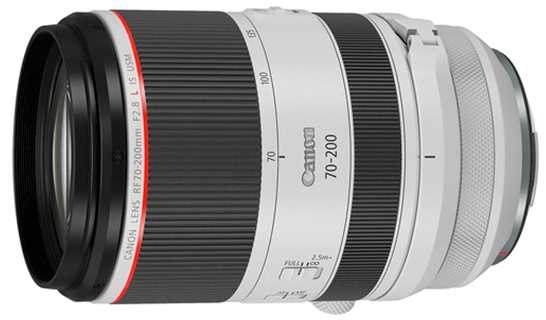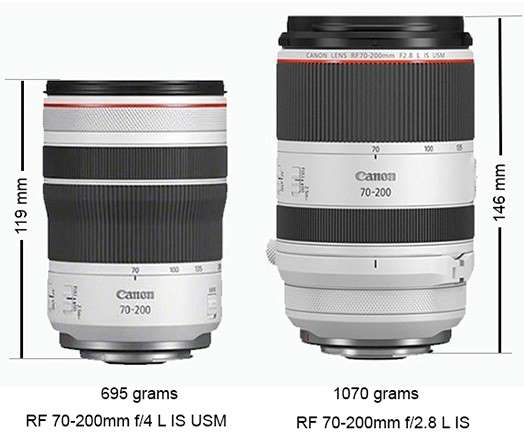CANON RF 70-200mm F/4 L IS USM: A smaller, lighter and more affordable alternative to the RF 70-200mm f/2.8L IS USM lens but also an excellent performer. It represents a wise choice for photographers who don’t need the one-stop advantage the f2.8L lens, as well as those looking for a more portable lens for hand-held shooting.
RRP: $3079 (street prices lower, so shop around).
 The numbers tell the story: Canon’s RF 70-200mm f/4L IS USM is just over 7 percent smaller in diameter, 81.5 percent of the length and approximately 65 percent of the weight of the RF 70-200mm f/2.8L IS USM lens and roughly 60 percent of its price. Those figures alone should attract potential buyers with EOS R-series cameras. The f44 lens is for hand-held shooting so it’s not supplied with a tripod mount. But, like the f2.8 lens it is made primarily from ‘engineering-quality’ plastic and features the same white heat shield coating. Interestingly, neither lens is compatible with Canon’s RF teleconverters.
The numbers tell the story: Canon’s RF 70-200mm f/4L IS USM is just over 7 percent smaller in diameter, 81.5 percent of the length and approximately 65 percent of the weight of the RF 70-200mm f/2.8L IS USM lens and roughly 60 percent of its price. Those figures alone should attract potential buyers with EOS R-series cameras. The f44 lens is for hand-held shooting so it’s not supplied with a tripod mount. But, like the f2.8 lens it is made primarily from ‘engineering-quality’ plastic and features the same white heat shield coating. Interestingly, neither lens is compatible with Canon’s RF teleconverters.
The 70-200mm zoom range is a popular extension to 24-70mm zooms and works well for sports and wildlife shooting at longer focal lengths and portraiture at focal lengths between 70mm and about 105mm, where it provides a natural-looking perspective. The retracting design extends the inner barrel by approximately 57mm when the lens is zoomed from the 70mm to the 200mm position.
Autofocusing is controlled by a Dual Nano USM system that independently adjusts the focusing and floating lens groups to prevent shifts in the focus position while zooming and when shooting close-ups. The floating focus element also reduces focus breathing – change in focal length that occurs as a result of adjusting the focusing distance of a lens – making this lens well suited to videography. Full-time manual focus control is available when working in the one-shot AF mode. The lens can focus to a minimum distance of 60cm over the entire zoom range, providing just over a quarter life size reproduction.
Our Imatest tests showed the review lens to be a good performer with measurements on both JPEG and CR3.RAW files comfortably exceeding expectations for the 20-megapixel sensor in the EOS R6 camera we used for testing. Diffraction began to take effect at f/11. Lateral chromatic aberration remained well down in the ‘negligible’ band for both JPEGs and CR3.RAW files. Bokeh was mostly smooth and attractive.
The lens is supplied with end caps, the ET-83G lens hood, which also has the white heat shield coating and is reversible over the barrel for transport and storage. The LP1319 lens pouch is also provided.

Purchasing Points:
1. Made in Japan, this lens boasts the same white heat shield coating as the RF 70-200mm f/2.8 L IS USM, which reflects heat to keep the temperature inside the lens relatively low when shooting on hot days.
2. Extensive weather-resistant sealing includes filters around the rings, switches, and extending/retracting parts of the lens to keep out dust and moisture.
3. The review lens felt equally well-balanced on the EOS R5/R6 and entry-level EOS RP cameras.
4. The built-in Optical Image Stabiliser provides up to five stops of shake correction or up to 7.5 stops when the lens is paired with an EOS R-type body with IBIS, such as the R5 or R6.
5. Three selectable stabiliser modes are available, optimising the system to correct multi-directional vibrations, vertical camera shake during panning and when following fast and irregularly moving subjects.
6. Proprietary Air Sphere Coating (ASC) has been applied to lens elements to suppress ghosting and flare, while the front and rear elements have protective fluorine coatings to resist grease and make them easier to clean.
7. This lens accepts 77mm diameter filters and can be used with graduates and polarisers without requiring adjustments when focusing and/or zooming.
8. The Dual Nano USM AF system supports fast and quiet autofocusing with negligible focus breathing, making it ideal for both stills and video shooting. The minimum focus of 60 cm is 10 cm closer than the f/2.8 lens can focus.
9. With only a one-stop difference, the RF 70-200mm f/4L IS USM is a better choice for photographers who don’t need the speed the f/2.8L lens provides.
10. The lens comes with front and end caps plus a petal-shaped lens hood with a locking button and a soft carrying pouch.
Distributor: Canon Australia; 1800 021 167; www.canon.com.au
– Margaret Brown

For a more comprehensive review of the lens, including resolution and chromatic aberration charts, click here.





Be First to Comment